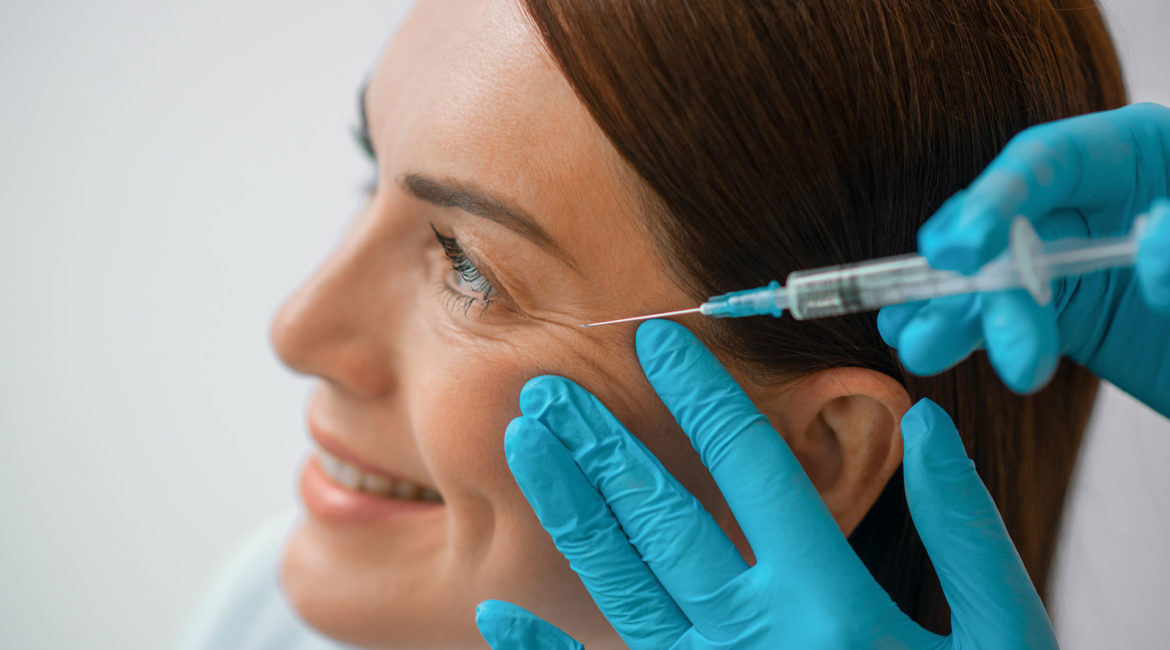Contents
Botox Injection: What is it & Its Procedure
Botox injections use a toxin called onobotulinumtoxinA to temporarily prevent a muscles from moving. This toxin is produced by the microbe that causes botulism, a type of food poisoning.
Botox was the first drug to use botulinum toxin. Other botulinum toxin type include abobotulinumtoxinA (Dysport), rimabotulinumtoxinB (Myobloc) and incobotulinumtoxinA (Xeomin). Each is a little different, particularly when it comes to dosage units, so they aren’t interchangeable.

What is botox?
The cosmetic form of botulinum toxin, sometimes referred to as “Botox” by patients, is a popular cosmetic botox injectable that temporarily reduces or eliminates facial wrinkles. This minimally invasive procedure uses a type of toxin from bacterium clostridium botulinum. The most commonly treated lines and wrinkles areas are frown lines, forehead creases and crow’s feet near the eyes.
What does botox do?
Botulinum toxin injections block certain nerve signals, mostly nerve signals that cause muscle to contract. The most common use of these botox therapy is to improve the appearance of facial, temporarily relax the facial muscles that cause facial wrinkles, fine lines at the forehead and around the eyes. Botox cosmetic injections are also used to treat health conditions that affect how the body functions. Examples include:
· Cervical dystonia.
In this painful condition, your neck muscle contract involuntarily causing your head to twist or turn into an uncomfortable position, severe neck spasms.
· Double vision.
The most common cause of double vision is an imbalance in the muscle responsible for positioning the eye.
· Muscle contractures.
Some neurological disorder conditions, such as cerebral palsy, can cause your limbs to pull in toward your center. In some cases, these contracted muscle can be relaxed with botox cosmetic treatment.
· Hyperhidrosis.
In this condition, excessive sweating occurs even when the temperature isn’t hot and you’re not exerting yourself.
· Chronic migraines.
If you experience chronic migraines more than 15 days a month, Botox injections may help reduce headache frequency.
· Overactive bladder.
Botox injections can also help reduce urinary incontinence caused by an overactive bladder.
· Eye twitching.
Botulinum toxin cosmetic treatments may help relieve contracture or twitching of muscle around the eye.
How does botox work?
Neurotoxins like botox injections disrupt signals from the nerves that stimulate specific muscles contraction. Essentially this temporarily paralyzes the facial muscles so that they cannot contract, causing wrinkles to soften and relax. The treatment works best on forehead lines, crow’s feet, skin folds and frown lines.

Is there a risk or side effects?
Botox cosmetic treatment are relatively safe when performed by an experienced doctor. Possible side effects and complications include:
· Mild pain or bruising at the injection site
· Headache or flu-like symptoms
· Droopy eyelid or cockeyed eyebrows
· Crooked smile or drooling
· Eye dryness or excessive tearing
Although is very unlikely, it is possible for the botulinum toxin in the injection to spread in your body. Call your doctor right away if you notice any of these effects hours to weeks after receiving Botox:
· Muscles weakness or numbness
· Vision problems
· Trouble speaking or swallowing
· Difficulty breathing
· Urinary incontinence
Doctors generally recommend against using Botox when you’re pregnant or breast-feeding. And Botox should not be used in people who are allergic to cow’s milk protein.
Botox Procedure
Before the procedure, patients may elect to have their skin numbed on the treatment area to prevent soreness and discomfort. There are various methods to numb the area, such as topical anesthesia, ice and vibration anesthesia to reduce pain and discomfort.

Before
- Avoid taking blood thinners or other non-steroidal anti-inflammatory drugs for several days prior to botulinum toxin injection to reduce risk of swelling or bruising.
- Avoid alcohol beverages for 24 hours before botox treatments as this can promote bleeding and bruising at the injection sites.
- Always inform your doctor of all medical conditions, health conditions, medications, including supplements you may be taking as well as your medical conditions history to get optimal results.
During
- Botox injections is simple and quick. Doctor uses a thin needle to give small doses injections of botulinum toxin into your skin or muscles. The number of injections needed depends on many factors, including the extent of the treated area.
After
- Do not massage, apply pressure and avoid rubbing on the injection site for 6-8 hours after botox injections since botox may migrate to other areas as well as affect the effects of botox.
- Avoid strenuous exercise. Botox will take about 20 minutes to settle in the muscles, and while you could potentially still hit the gym later in the day after 6 hours. However, after a day you are more than welcome to return to your normal activities.
- While alcohol consumption after Botox is not usually a risk, it is recommended not to drink alcohol for 24 hours as a precautionary measure to prevent bruising. Alcohol is a blood-thinner, so it could potentially exacerbate bruising and swelling. Some patients also experience dizziness or drowsiness after botox treatment, which can worsen with alcohol consumption.
Frequently Asked Questions
Is botox painful?
There is no excessive pain associated with Botox injections. You may feel some stinging at the injection site, but anesthetic cream or ice pack can numb the area.
Who should not get a botox Injection?
Your body health need to be in good condition and at least 18 years old before you can get botox cosmetic injections.
Some people should not get botox treatments. These include those who:
- have a neuromuscular disease (such as multiple sclerosis or myasthenia gravis)
- are pregnant or nursing
- have weakness in certain facial muscle
- have ptosis (droopy eyelids), deep facial scars, or uneven facial features (when features are not the same on both sides of the face)
- have skin problems near the treated area
How long does botox treatment last?
The effects from Botox will last 3 to 6 months. As nearby muscles action slowly return, the lines and wrinkles begin to reappear and need to be treated again. The fine lines and wrinkles often appear less severe overtime because the muscle are shrinking.
What is botox made of?
Botox is a drug made from a toxin produced by the bacterium clostridium botulinum. It’s the same botulinum toxin type that causes a life-threatening type of food poisoning called botulism.
What are the differences between Botox and Dermal Fillers?
- Botox contains purified bacteria that freeze muscle. In doing so, Botox can reduce the appearance of fine lines and wrinkles caused by facial expressions.
- Dermal fillers contain hyaluronic acid ingredients that add fullness to areas that have thinned due to aging. This thinning is common in the cheeks, lips, and around the mouth.

Botox and fillers are different substances designed for different cosmetic purposes, they can sometimes be combined in one treatment. For instance, someone may use Botox to correct lines between the eyes and a filler to correct smile lines around the mouth.
Conclusion
When experienced clinicians perform the treatment, Botox is minimally invasive solutions and safe for cosmetic reasons. It does not result in any adverse side effects from clinical trials and peer reviewed studies. Side effects are mainly minor and rarely occur in most clients.
In addition, we do not recommend Botox for women who are pregnant or breastfeeding. People who have certain health condition or who take any medications should discuss with a doctor or healthcare provider whether the treatment are safe for them.
It is important that you ensure that the clinic you are looking into has a qualified doctor administering the treatment, prescribing information regarding the clients’ overall health aspects and professional with in-depth anatomical knowledge is an even safer choice.




